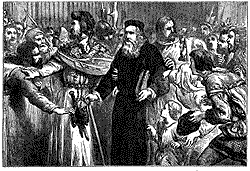I can’t resist creating an entry on this. In the process of compiling bibliography on Wyclif and his followers I’ve come across many fictional treatments of Wyclif and Wycliffites. I’ve now listed those I know of on their own page on this site. You can find them in hard copies on eBay and Amazon and used-book sites, often in reprints which would seem to indicate their enduring popularity. Wyclif and his followers have been used, it would seem, in the way that Arthur and his knights are depicted–not as an indication of what they were (even if Wyclif was significantly more authentic than Arthur), but as what later cultures have wanted them to be.

A bookshelf of novels appeared during the decades surrounding the quincentenary of Wyclif’s death in 1884 which, next to the (themselves often novelistic) also booming trade in biographies of Wyclif, often portrayed Wyclif and his followers as the brave, lonely proto-protestants who dreamed of ending the corruption of the benighted, Catholic, Latinate world around them (that’s sarcasm, so don’t quote that like I mean it). They feature great deeds, meaningful and secret conversations, glimpses of great men and women, and martyrs being burned. Frances Eastwood’s Geoffrey the Lollard (1870) is one (no connection to Chaucer here; Geoffrey is a boy). The prolific Emily Sarah Holt wrote dozens of children’s novels, including at least one of which, Mistress Margery: A Tale of the Lollards (1868), includes a female Wycliffite heroine. Holt was also apparently the author of a biography of Wyclif. Some, including novels by Emily Watson, another prolific writer of children’s novels, include tales which travel to Bohemia. At least three, by Watson (Dearer than Life: “And then another raised the shout, ‘God bless Wycliffe, and all “poor priests!”‘ which was enough in the minds of many to identify the whole movement with the reformer himself” [179]), Harriete Burch, and Annie Meyer, include the 1381 Peasant’s Revolt. Some carry forward into the fifteenth and sixteenth centuries and the reformation.
Not all were targeted at children. One, by Charles Sayles, is a play, written in iambic pentameter no less; and one volume includes a series of “Wycliffe Ballads” in a volume of verse which re-capture many of the foundational, inaccurate clichés about “the morning star of the reformation”:
For ’twas Wycliffe’s vow, before he left that convalescent couch
Where the Friars looked to find him in remorseful anguish crouch–“I will fill the realm of England with God’s light; so priestly fears
Shall make hast to flee, as spectres of the night when morn appears.From Truth’s Latin-darkened lantern I have flashed some ray’s o’ the Light,
Just enough to show the dangers and denseneess of the night . . . “
It should be noted that there is also fiction and poetry here which responds to modern scholarship about Wyclif. Vantrease’s novels, for example, seem to be part of the sub-genre one might describe as “costume dramas” (to abduct a phrase usually applied to films) or period dramas, in the vein of writers such as Margaret George or Sharon Kay Penman. And in 2006 Thom Satterlee wrote a rewarding volume of poetry entitled Burning Wyclif.
This is fabulous! Thanks so much for posting!